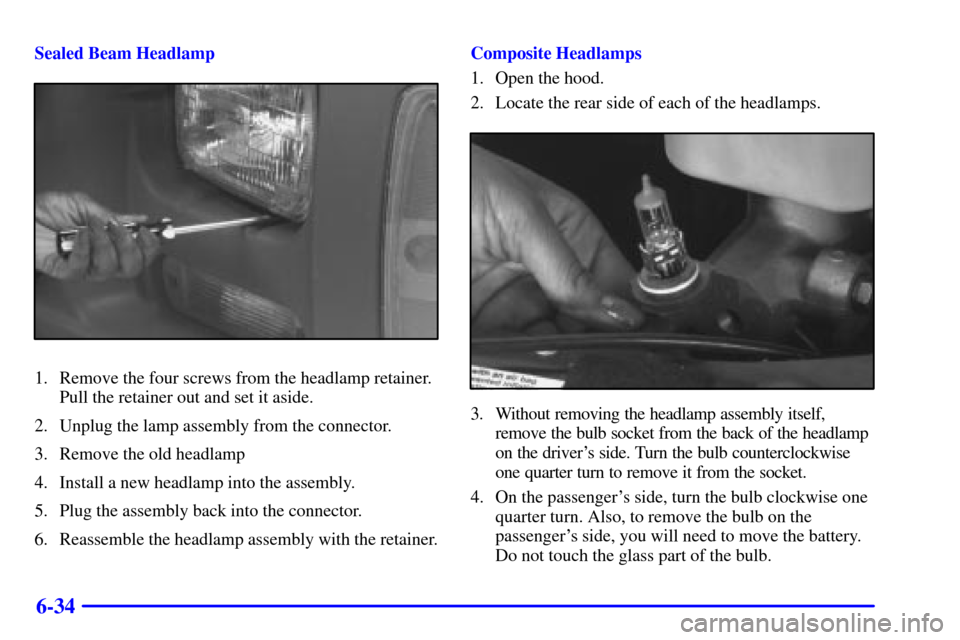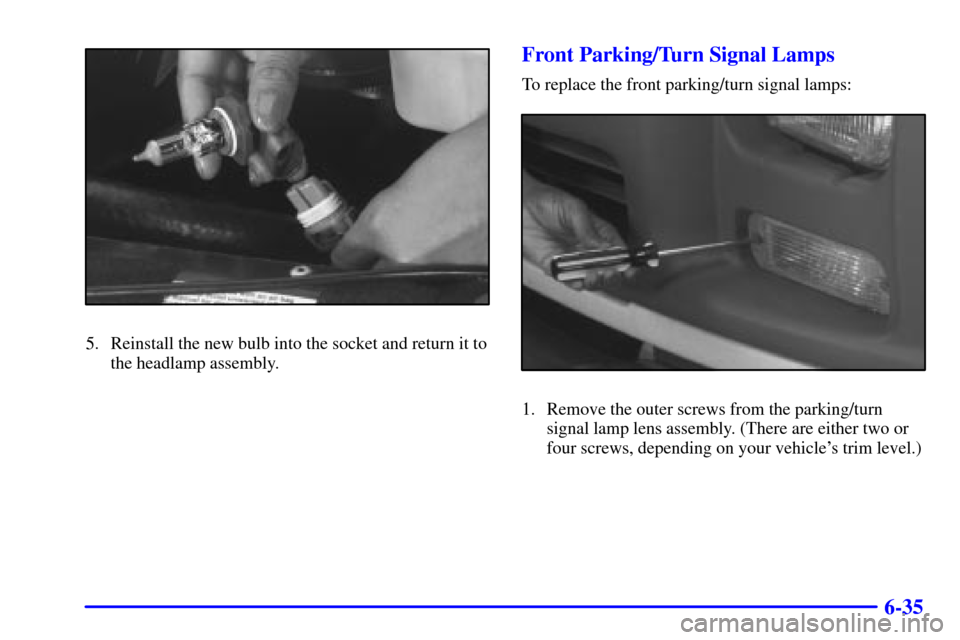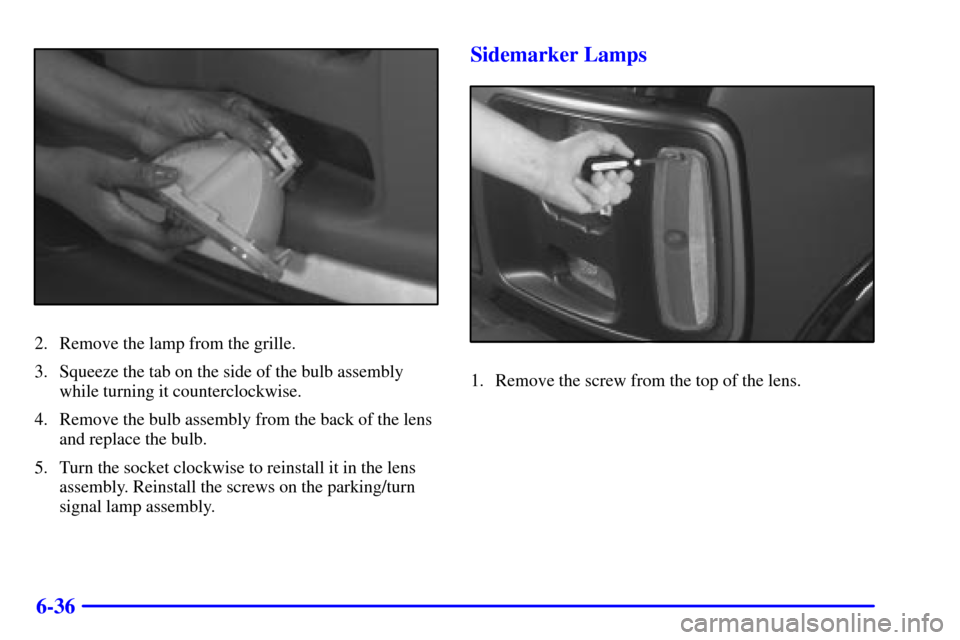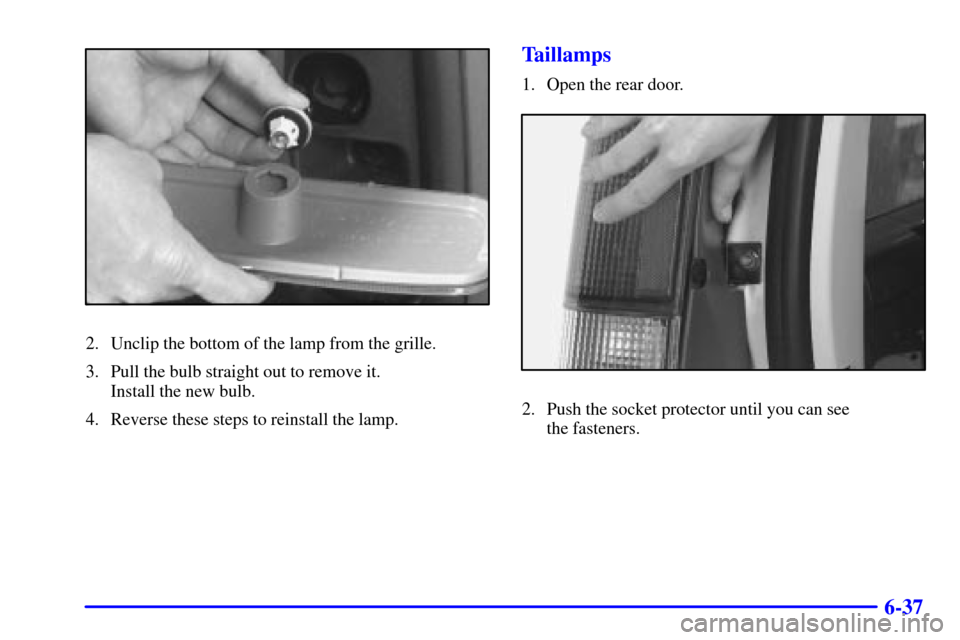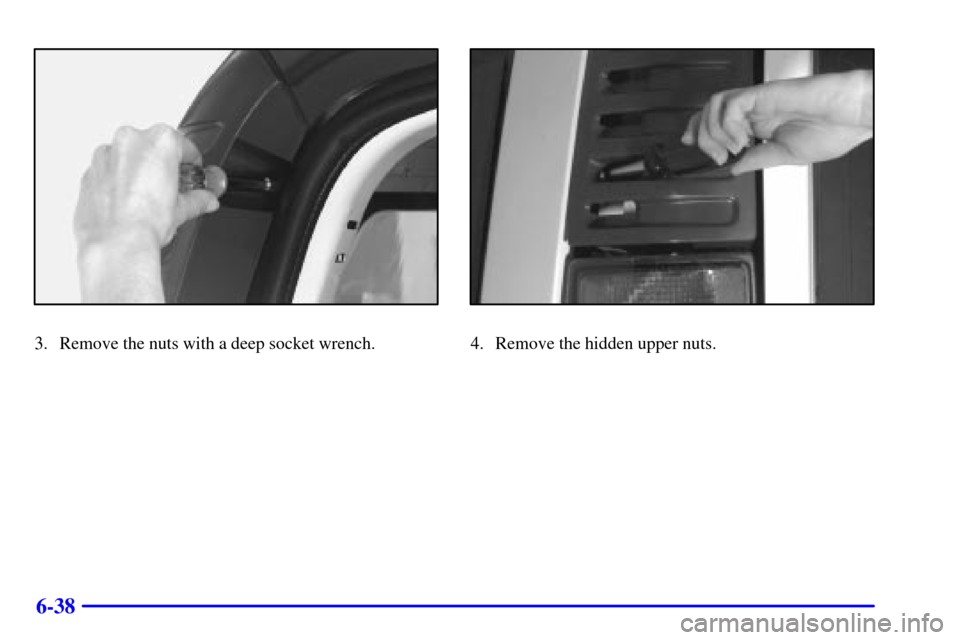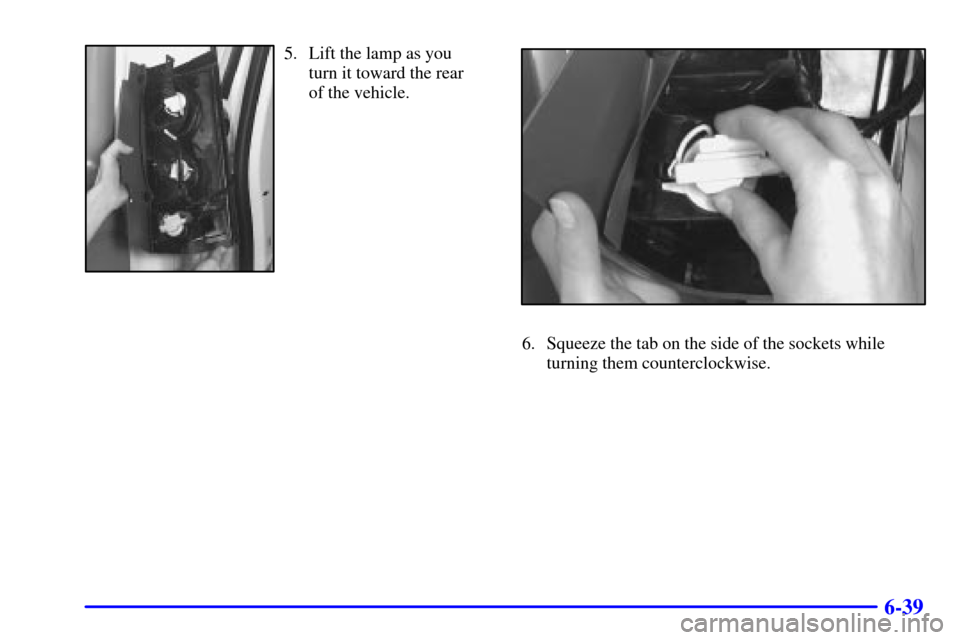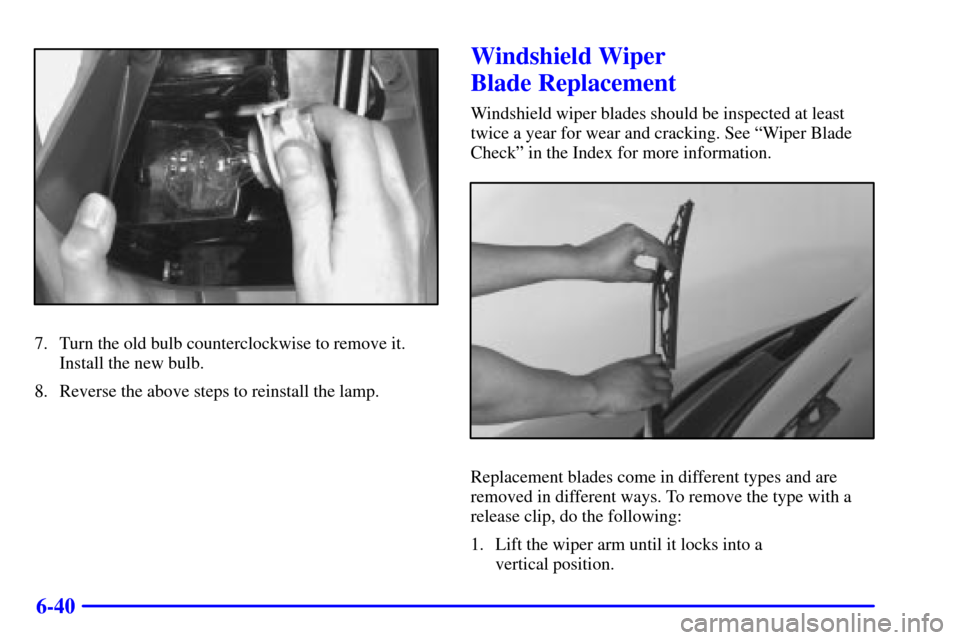CHEVROLET EXPRESS CARGO VAN 2001 1.G Owners Manual
EXPRESS CARGO VAN 2001 1.G
CHEVROLET
CHEVROLET
https://www.carmanualsonline.info/img/24/8177/w960_8177-0.png
CHEVROLET EXPRESS CARGO VAN 2001 1.G Owners Manual
Trending: oil reset, tires, radio controls, windshield wipers, change wheel, gas type, low oil pressure
Page 301 of 412

6-32 Brake Adjustment
Every time you make a brake stop, your disc brakes
adjust for wear.
If your brake pedal goes down farther than normal, your
rear drum brakes may need adjustment. Adjust them by
backing up and firmly applying the brakes a few times.
Replacing Brake System Parts
The braking system on a vehicle is complex. Its many
parts have to be of top quality and work well together if
the vehicle is to have really good braking. Your vehicle
was designed and tested with top
-quality GM brake
parts. When you replace parts of your braking
system
-- for example, when your brake linings wear
down and you have to have new ones put in
-- be sure
you get new approved GM replacement parts. If you
don't, your brakes may no longer work properly. For
example, if someone puts in brake linings that are wrong
for your vehicle, the balance between your front and
rear brakes can change
-- for the worse. The braking
performance you've come to expect can change in many
other ways if someone puts in the wrong replacement
brake parts.
Battery
Your new vehicle comes with a maintenance free
ACDelco� battery. When it's time for a new battery, get
one that has the replacement number shown on the
original battery's label. We recommend an ACDelco
battery. See ªEngine Compartment Overviewº in the
Index for battery location.
WARNING: Battery posts, terminals and related
accessories contain lead and lead compounds, chemicals
known to the State of California to cause cancer and
reproductive harm. Wash hands after handling.
If you have a diesel engine, you have two batteries. The
primary battery is located on the passenger's side of the
engine compartment. The second battery is located on
the driver's side framerail.
Page 302 of 412
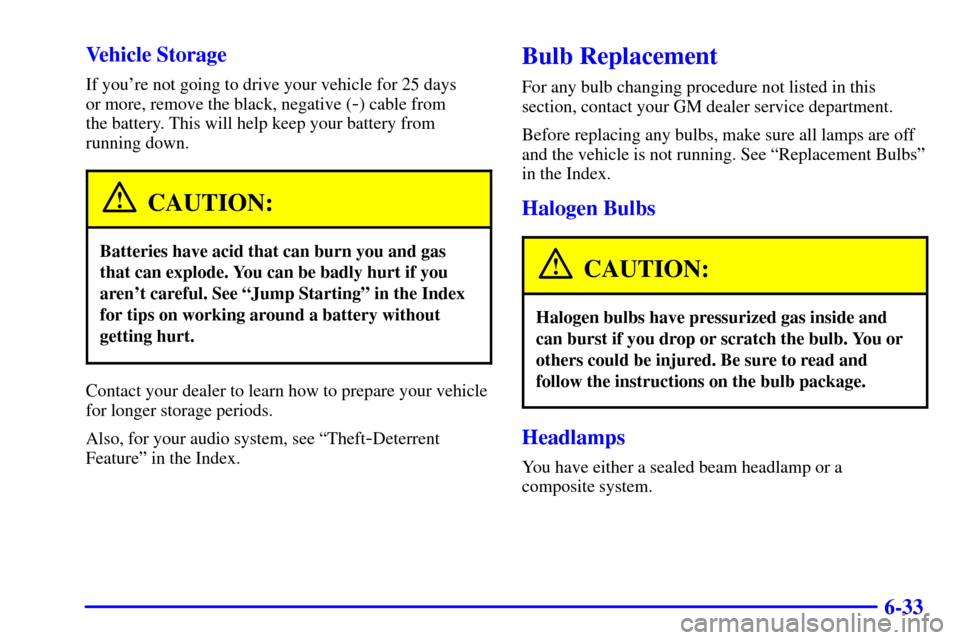
6-33 Vehicle Storage
If you're not going to drive your vehicle for 25 days
or more, remove the black, negative (
-) cable from
the battery. This will help keep your battery from
running down.
CAUTION:
Batteries have acid that can burn you and gas
that can explode. You can be badly hurt if you
aren't careful. See ªJump Startingº in the Index
for tips on working around a battery without
getting hurt.
Contact your dealer to learn how to prepare your vehicle
for longer storage periods.
Also, for your audio system, see ªTheft
-Deterrent
Featureº in the Index.
Bulb Replacement
For any bulb changing procedure not listed in this
section, contact your GM dealer service department.
Before replacing any bulbs, make sure all lamps are off
and the vehicle is not running. See ªReplacement Bulbsº
in the Index.
Halogen Bulbs
CAUTION:
Halogen bulbs have pressurized gas inside and
can burst if you drop or scratch the bulb. You or
others could be injured. Be sure to read and
follow the instructions on the bulb package.
Headlamps
You have either a sealed beam headlamp or a
composite system.
Page 303 of 412
6-34
Sealed Beam Headlamp
1. Remove the four screws from the headlamp retainer.
Pull the retainer out and set it aside.
2. Unplug the lamp assembly from the connector.
3. Remove the old headlamp
4. Install a new headlamp into the assembly.
5. Plug the assembly back into the connector.
6. Reassemble the headlamp assembly with the retainer.Composite Headlamps
1. Open the hood.
2. Locate the rear side of each of the headlamps.
3. Without removing the headlamp assembly itself,
remove the bulb socket from the back of the headlamp
on the driver's side. Turn the bulb counterclockwise
one quarter turn to remove it from the socket.
4. On the passenger's side, turn the bulb clockwise one
quarter turn. Also, to remove the bulb on the
passenger's side, you will need to move the battery.
Do not touch the glass part of the bulb.
Page 304 of 412
6-35
5. Reinstall the new bulb into the socket and return it to
the headlamp assembly.
Front Parking/Turn Signal Lamps
To replace the front parking/turn signal lamps:
1. Remove the outer screws from the parking/turn
signal lamp lens assembly. (There are either two or
four screws, depending on your vehicle's trim level.)
Page 305 of 412
6-36
2. Remove the lamp from the grille.
3. Squeeze the tab on the side of the bulb assembly
while turning it counterclockwise.
4. Remove the bulb assembly from the back of the lens
and replace the bulb.
5. Turn the socket clockwise to reinstall it in the lens
assembly. Reinstall the screws on the parking/turn
signal lamp assembly.
Sidemarker Lamps
1. Remove the screw from the top of the lens.
Page 306 of 412
6-37
2. Unclip the bottom of the lamp from the grille.
3. Pull the bulb straight out to remove it.
Install the new bulb.
4. Reverse these steps to reinstall the lamp.
Taillamps
1. Open the rear door.
2. Push the socket protector until you can see
the fasteners.
Page 307 of 412
6-38
3. Remove the nuts with a deep socket wrench.4. Remove the hidden upper nuts.
Page 308 of 412
6-39
5. Lift the lamp as you
turn it toward the rear
of the vehicle.
6. Squeeze the tab on the side of the sockets while
turning them counterclockwise.
Page 309 of 412
6-40
7. Turn the old bulb counterclockwise to remove it.
Install the new bulb.
8. Reverse the above steps to reinstall the lamp.
Windshield Wiper
Blade Replacement
Windshield wiper blades should be inspected at least
twice a year for wear and cracking. See ªWiper Blade
Checkº in the Index for more information.
Replacement blades come in different types and are
removed in different ways. To remove the type with a
release clip, do the following:
1. Lift the wiper arm until it locks into a
vertical position.
Page 310 of 412
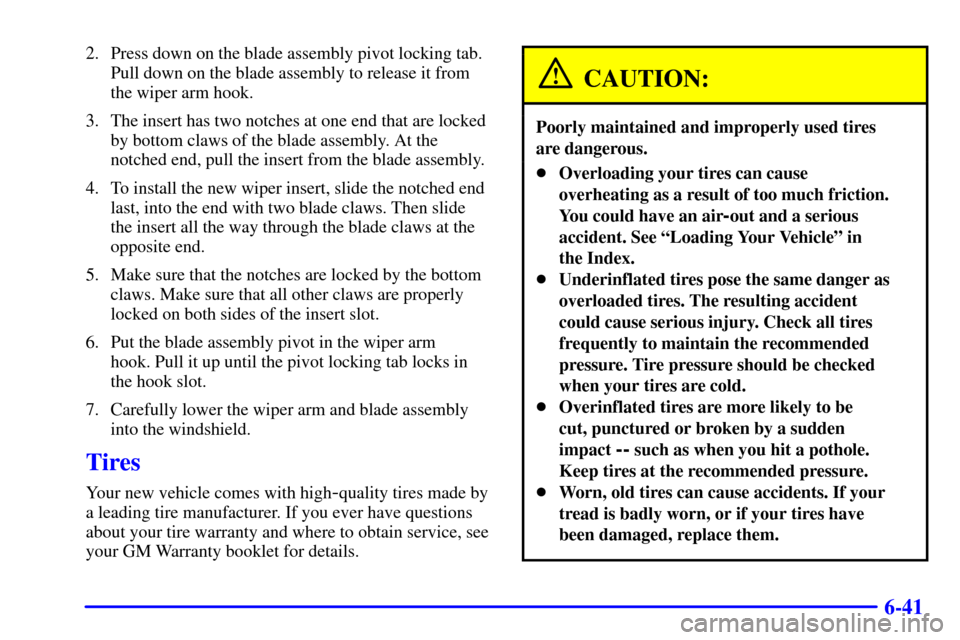
6-41
2. Press down on the blade assembly pivot locking tab.
Pull down on the blade assembly to release it from
the wiper arm hook.
3. The insert has two notches at one end that are locked
by bottom claws of the blade assembly. At the
notched end, pull the insert from the blade assembly.
4. To install the new wiper insert, slide the notched end
last, into the end with two blade claws. Then slide
the insert all the way through the blade claws at the
opposite end.
5. Make sure that the notches are locked by the bottom
claws. Make sure that all other claws are properly
locked on both sides of the insert slot.
6. Put the blade assembly pivot in the wiper arm
hook. Pull it up until the pivot locking tab locks in
the hook slot.
7. Carefully lower the wiper arm and blade assembly
into the windshield.
Tires
Your new vehicle comes with high-quality tires made by
a leading tire manufacturer. If you ever have questions
about your tire warranty and where to obtain service, see
your GM Warranty booklet for details.
CAUTION:
Poorly maintained and improperly used tires
are dangerous.
�Overloading your tires can cause
overheating as a result of too much friction.
You could have an air
-out and a serious
accident. See ªLoading Your Vehicleº in
the Index.
�Underinflated tires pose the same danger as
overloaded tires. The resulting accident
could cause serious injury. Check all tires
frequently to maintain the recommended
pressure. Tire pressure should be checked
when your tires are cold.
�Overinflated tires are more likely to be
cut, punctured or broken by a sudden
impact
-- such as when you hit a pothole.
Keep tires at the recommended pressure.
�Worn, old tires can cause accidents. If your
tread is badly worn, or if your tires have
been damaged, replace them.
Trending: child restraint, cooling, stop start, change wheel, oil additives, adding oil, manual radio set


